Toilet Room Doors.
Sections 4.22.2 and 4.22.3 of the 1991 Standards and Section 603.2.3 of the 2010 Standards permit the doors of all toilet or bathing rooms with in-swinging doors to swing into the required turning space, but not into the clear floor space required at any fixture. In single-user toilet rooms or bathing rooms, Section 603.2.3 Exception 2 of the 2010 Standards permits the door to swing into the clear floor space of an accessible fixture if a clear floor space that measures at least 30 inches by 48 inches is provided outside of the door swing.
Several commenters expressed reservations about Exception 2 of Section 603.2.3. Concerns were raised that permitting doors of single-user toilet or bathing rooms with in-swinging doors to swing into the clearance around any fixture will result in inaccessibility to individuals using larger wheelchairs and scooters. Additionally, a commenter stated that the exception would require an unacceptable amount of precision maneuvering by individuals who use standard size wheelchairs. The Department believes that this provision achieves necessary flexibility while providing a minimum standard for maneuvering space. The standard does permit additional maneuvering space to be provided, if needed.
In the NPRM, the Department provided a series of plan drawings illustrating comparisons of the minimum size single-user toilet rooms. These floor plans showed typical examples that met the minimum requirements of the proposed ADA Standards. A commenter was of the opinion that the single-user toilet plans shown in the NPRM demonstrated that the new requirements will not result in a substantial increase in room size. Several other commenters representing industry offered criticisms of the single-user toilet floor plans to support their assertion that a 2010 Standards-compliant single-user toilet room will never be smaller and will likely be larger than such a toilet room required under the 1991 Standards. Commenters also asserted that the floor plans prepared by the Department were of a very basic design which could be accommodated in a minimal sized space whereas the types of facilities their customers demand would require additional space to be added to the rooms shown in the floor plans. The Department recognizes that there are many design choices that can affect the size of a room or space. Choices to install additional features may result in more space being needed to provide sufficient clear floor space for that additional feature to comply. However, many facilities that have these extra features also tend to have ample space to meet accessibility requirements. Other commenters asserted that public single-user toilet rooms always include a closer and a latch on the entry door, requiring a larger clear floor space than shown on the push side of the door shown in Plan 1B. The Department acknowledges that in instances where a latch is provided and a closer is required by other regulations or codes, the minimum size of a room with an out-swinging door may be slightly larger than as shown in Plan 1C.
Additional floor plans of single-user toilet rooms are now included in further response to the commentary received.
Comparison of Single-User Toilet Room Layouts: 1A, 1B, and 1C
|
1991 Standards 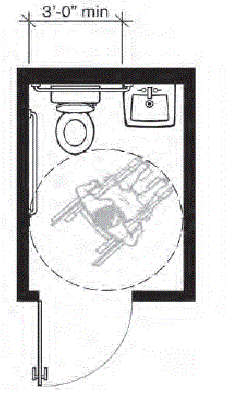 Plan-1A: 1991 Standards Minimum with Out-Swinging Door 5’-0" x 7’-3" • 36.25 Square Feet |
| This plan shows a typical example of a single-user toilet room that meets the minimum requirements of the 1991 Standards. The size of this space is determined by the minimum width required for the water closet and lavatory between the side walls, the minimum wheelchair turning space, and the space required for the out-swinging door. A lavatory with knee space can overlap the clear floor space required for the water closet provided that at least 36 inches of clearance is maintained between the side wall next to the water closet and the lavatory (see section 4.16.2 and Fig. 28 of the 1991 Standards). A wheelchair turning space meeting section 4.2.3 of the 1991 Standards must be provided. The size of this room requires that the entry door swing out. The room would be larger if the door were in-swinging. |
|
2010 Standards 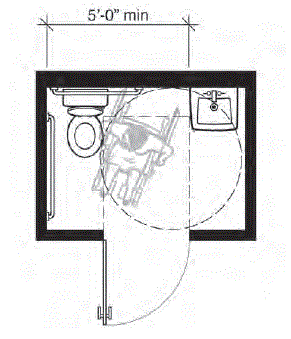 Plan-1B: 2010 Standards Minimum with Out-Swinging Door 7’-0" x 5’-0" • 35.00 Square Feet |
|
This plan shows a typical example of a single-user toilet room that meets the minimum requirements of the 2010 Standards. Features include: five-foot minimum width between the side wall of the water closet and the lavatory; 60-inch minimum circular wheelchair turning space; and 36-inch by 48-inch clear maneuvering space for the out-swinging entry door. Section 604.3.1 of the 2010 Standards requires a floor clearance at a water closet that is a minimum of 60 inches wide by 56 inches deep regardless of approach. Section 604.3.2 prohibits any other plumbing fixtures from being located in this clear space, except in residential dwelling units. The 2010 Standards, at section 304.3, allows the turning space to extend into toe and knee space provided beneath fixtures and other elements. Required maneuvering space for the entry door (inside the room) must be clear of all fixtures. If the door had both a closer and latch, section 404.2.4.1 and Figure 404.2.4.1(c) require additional space on the latch side. This layout is three point five percent (3.5%) smaller than the accompanying Plan−1A: 1991 Standards Minimum with Out-Swinging Door example. |
|
2010 Standards 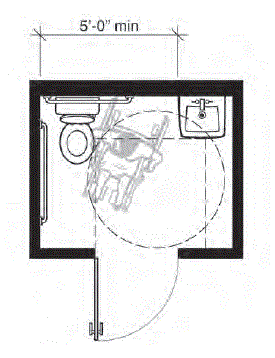 Plan-1C: 2010 Standards Minimum with Out-Swinging Door (entry door has both closer and latch) |
|
This plan shows the same typical features of a single-user toilet room that meets the minimum requirements of the 2010 Standards as Plan−1B does except the entry door has both a closer and latch. Because the door has both a closer and latch, a minimum additional foot of maneuvering space is required on the latch side (see section 404.2.4.1 and Figure 404.2.4.1(c) of the 2010 Standards). This layout is six point two percent (6.2%) larger than the accompanying Plan−1A: 1991 Standards Minimum with Out-Swinging Door example. |
Comparison of Single-User Toilet Room Layouts: 2A, 2B, and 2C
|
1991 Standards 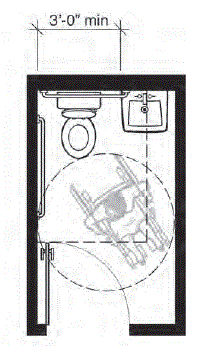 Plan-2A: 1991 Standards Minimum with In-Swinging Door 5’-0" x 8’-6" • 42.50 Square Feet |
| This plan shows a typical example of a single-user toilet room that meets the minimum requirements of the 1991 Standards. Depending on the width of the hallway and other circulation issues, it can be preferable to swing the entry door into the toilet room. Businesses and public entities typically prefer to have an in-swinging door. The in-swinging door increases overall room size because it cannot swing over the required clear floor space at any accessible fixture, (see section 4.22.2 of the 1991 Standards). This increases the room depth from Plan−1A. The door is permitted to swing over the required turning space shown as a 60-inch circle. |
|
2010 Standards 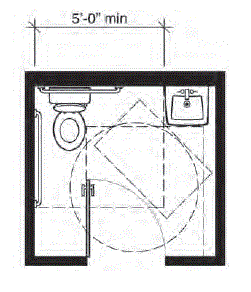 Plan-2B: 2010 Standards Minimum with In-Swinging Door 7’-0" x 6’-6" • 45.50 Square Feet |
|
This plan shows a typical example of a single-user toilet room that meets the minimum requirements of the 2010 Standards when the entry door swings into the room. In the 2010 Standards an exception allows the entry door to swing over the clear floor spaces and clearances required at the fixtures if a clear floor space complying with section 305.3 (minimum 30 inches by 48 inches) is provided outside the arc of the door swing, section 603.3.3 exception 2. The required maneuvering space for the door, section 404.2.4.1 and Figure 404.2.4.1(a), also is a factor in room size. This clear space cannot be obstructed by the plumbing fixtures. Note that this layout provides more space for turning when the door is closed than Plan−1B. This layout is seven percent (7%) larger than the accompanying Plan−2A: 1991 Standards Minimum with In-Swinging Door example. |
|
2010 Standards 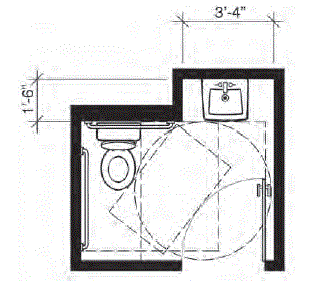 Plan-2C: 2010 Standards Minimum with In-Swinging Door 7’-0" x 6’-6" • 40.00 Square Feet (plumbing chase not included) |
|
This plan shows the same typical features of a single-user toilet room that meets the minimum requirements of the 2010 Standards as Plan−2B when the entry door swings into the room. Note that this layout also provides more space for turning when the door is closed than Plan−1B. This layout is six point two five percent (6.25%) smaller than the accompanying Plan−2A: 1991 Standards Minimum with In-Swinging Door example. |
Comparison of Single-User Toilet Room Layouts: Plan 3
|
1991 Standards and 2010 Standards 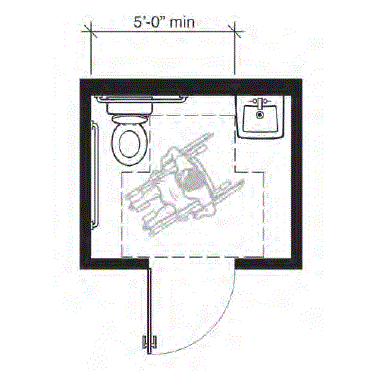 Plan-3: Meets Both 1991 Standards and 2010 Standards 7’-0" x 5’-9" • 40.25 Square Feet |
|
This plan shows an example of a single-user toilet room that meets the minimum requirements of both the 1991 Standards and 2010 Standards. A T-shaped turning space has been used (see Fig. 3(a) of the 1991 Standards and Figure 304.3.2 of the 2010 Standards) to maintain a compact room size. An out-swinging door also minimizes the overall layout depth and cannot swing over the required clear floor space or clearance at any accessible plumbing fixture. This layout is eleven percent (11%) larger than the Plan−1A: 1991 Standards Minimum with Out-Swinging Door example shown at the beginning of these plan comparisons. |
Comparison of Single-User Toilet Room “Pairs” With Fixtures Side-by-Side: Plan 1A and Plan 1B
|
1991 Standards 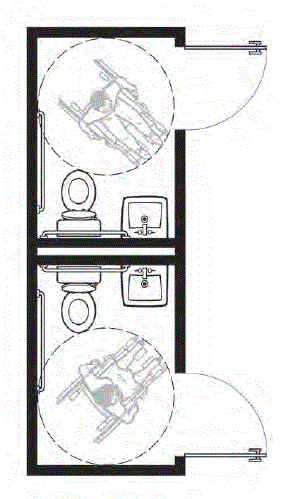 Plan-1A Pair: 1991 Standards with Out-Swinging Doors Two 5’-0" x 7’-3" Rooms – 72.50 Square Feet Total |
|
2010 Standards 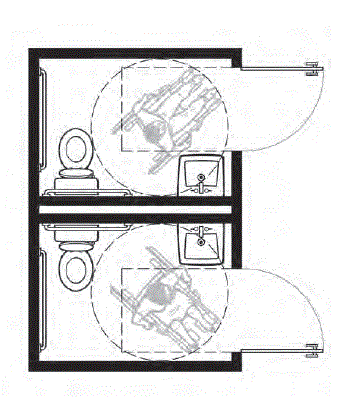 Plan-1B Pair: 2010 Standards with Out-Swinging Doors Two 7’-0" x 5’-0" Rooms – 70.00 Square Feet Total |
| These plans show men’s/women’s room configurations using Plans 1A and 1B. |
Comparison of Single-User Toilet Room “Pairs” With Fixtures Side-by-Side: Plan 2C
|
2010 Standards 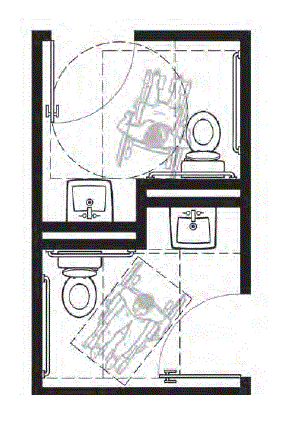 Plan-2C Pair: 2010 Standards with In-Swinging Doors Two 7’-2" x 6’-6" Rooms - 82.00 Square Feet Total |
| This plan shows a men’s/women’s room configuration using Plan 2C. |

User Comments/Questions
Add Comment/Question